India (Hindi: भारत Bharat; see also other languages), officially the Republic of India (Hindi: भारतीय गणराज्य Bharatiya Ganarajya), is a country in South Asia. It is the seventh largest country by geographical area, the second most populous country, and the largest democracy in the world. Bounded by the Indian Ocean on the south, the Arabian Sea on the west, and the Bay of Bengal on the east, India has a coastline of 7,517 kilometers (4,671 mi). It borders Pakistan to the west; China, Nepal, and Bhutan to the north-east; and Bangladesh and Burma to the east. The disputed Northern Areas of Jammu and Kashmir claimed by India and currently administered by Pakistan shares a small border with Afghanistan to the extreme northwest. Sri Lanka, Maldives, and Indonesia are in India's vicinity in Indian Ocean.
Home to the Indus Valley Civilization and a region of historic trade routes and vast empires, the Indian subcontinent was identified with its commercial and cultural wealth for much of its long history. Four major world religions, Hinduism, Buddhism, Jainism and Sikhism originated here, while Zoroastrianism, Judaism, Christianity and Islam arrived in the first millennium CE and shaped the region's diverse culture. Gradually annexed by the British East India Company from the early eighteenth century and colonised by the United Kingdom from the mid-nineteenth century, India became a modern nation state in 1947 after a struggle for independence that was marked by widespread nonviolent resistance.
India is the world's twelfth largest economy at market exchange rates and the third largest in purchasing power. Economic reforms have transformed it into the second fastest growing large economy; however, it still suffers from high levels of poverty, illiteracy, and malnutrition. As a pluralistic, multilingual, and multiethnic society, India is also home to a diversity of wildlife in a variety of protected habitats.
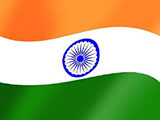
| Capital: | New Delhi |
| Largest city: | Mumbai |
| Official Languages: | Hindi, English |
| Scheduled Languages: | 8th Schedule |
| Demonym: | Indian |
| Government: | Federal republic Parliamentary democracy |
| Prime Minister | Narendra Modi |
| President | Ram Nath Kovind |
| Independence Declared Republic |
from British colonial rule 15 August 1947 26 January 1950 |
| Area Total Water (%) |
3,287,590‡ km² (7th) 1,269,346 sq mi Water (%) 9.56 |
| Population 2007 estimate 2001 census Density |
1.12 billion 1,027,015,248 329/km² (31st) 852/sq mi |
| GDP (PPP) Total Per capita |
2007 estimate $ 2.965 trillion $ 2700 (165th) |
| GDP (nominal) Total Per capita |
2007 estimate $ 1.089 trillion (12th) $ 977 (132nd) |
| Gini (2004) | 36.8 |
| HDI (2007) | 0.619 (medium) (128th) |
| Currency | Indian rupee (INR) |
| Time zone Summer (DST) |
IST (UTC+5:30) not observed (UTC+5:30) |
| Internet TLD | .in |
| Calling code | +91 |
The name India (pronounced) is derived from Indus, which is derived from the Old Persian word Hindu, from Sanskrit Sindhu, the historic local appellation for the Indus River. The ancient Greeks referred to the Indians as Indoi, the people of the Indus. The Constitution of India and common usage in various Indian languages also recognise Bharat as an official name of equal status. Hindustan which is the Persian word for "Land of the Hindus" and historically referred to northern India, is also occasionally used as a synonym for all of India.
Stone Age rock shelters with paintings at the Bhimbetka rock shelters in Madhya Pradesh are the earliest known traces of human life in India. The first known permanent settlements appeared over 9,000 years ago and gradually developed into the Indus Valley Civilization, dating back to 3300 BCE in western India. It was followed by the Vedic period, which laid the foundations of Hinduism and other cultural aspects of early Indian society, and ended in the 500s BC. From around 550 BCE, many independent kingdoms and republics known as the Mahajanapadas were established across the country.
The empire built by the Maurya Empire under Emperor Ashoka united most of South Asia in the third century BCE. From 180 BCE, a series of invasions from Central Asia followed, including those led by the Indo-Greeks, Indo-Scythians, Indo-Parthians and Kushans in the north-western Indian subcontinent. From the third century CE, the Gupta dynasty oversaw the period referred to as ancient "India's Golden Age. "Among the notable South Indian empires were the Chalukyas, Rashtrakutas, Hoysalas, Pallavas, Pandyas, and Cholas. Science, engineering, art, literature, astronomy, and philosophy flourished under the patronage of these kings.
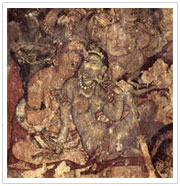
Following invasions from Central Asia between the tenth and twelfth centuries, much of north India came under the rule of the Delhi Sultanate, and later the Mughal Empire.
Mughal emperors gradually expanded their Kingdoms to coverlarge parts of the subcontinent.Nevertheless, several indigenous kingdoms, such as the Vijayanagara Empire, flourished, especially in the south. In the seventeenth and eighteenth century, the Mughal supremacy declined and the Maratha Empire became the dominant power.
From the sixteenth century, several European countries, including Portugal, the Netherlands, France, and the United Kingdom, started arriving as traders and later took advantage of the fractious nature of relations between the kingdoms to establish colonies in the country. By 1856, most of India was under the control of the British East India Company. A year later, a nationwide insurrection of rebelling military units and kingdoms, variously referred to as the First War of Indian Independence or Sepoy Mutiny, seriously challenged British rule but eventually failed. As a consequence, India came under the direct control of the British Crown as a colony of the British Empire.
During the first half of the twentieth century, a nationwide struggle for independence was launched by the Indian National Congress and other political organizations. In the 1920s and 1930, a movement led by Mahatma Gandhi, and displaying commitment to ahimsa, or non-violence, millions of protesters engaged in mass campaigns of civil disobedience. Finally, on 15 August 1947, India gained independence
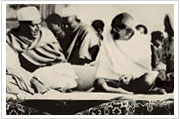
from British rule, but was partitioned with independent governments for the Dominion of India and the Dominion of Pakistan in accordance to wishes of the Muslim League, along the lines of religion to create the Islamic nation state of Pakistan. Three years later, on 26 January 1950, India became a republic and a new constitution came into effect.
Since independence, India has experienced sectarian violence and insurgencies in various parts of the country, but has maintained its unity and democracy. It has unresolved territorial disputes with China, which in 1962 escalated into the brief Sino-Indian War; and with Pakistan, which resulted in wars in 1947, 1965, 1971, and 1999. India is a founding member of the Non-Aligned Movement and the United Nations (as part of British India). In 1974, India conducted an underground nuclear test. This was followed by five more tests in 1998, making India a nuclear state. Beginning in 1991, significant economic reforms have transformed India into one of the fastest-growing economies in the world, adding to its global and regional clout.
 - National Symbols of India
- National Symbols of IndiaThe Constitution of India, the longest and the most exhaustive constitution of any independent nation in the world, came into force on January 26, 1950. The preamble of the constitution defines India as a sovereign, socialist, secular, democratic republic. India has a quasi-federal form of government and a bicameral parliament operating under a Westminster-style parliamentary system. It has three branches of governance: the Legislature, Executive, and Judiciary.
The President of India is the official head of state elected indirectly by an electoral college for a five-year term. The Prime Minister is, however, the de facto head of government and exercises most executive powers. The Prime Minister is appointed by the President and, by convention, is the candidate supported by the party or political alliance holding the majority of seats in the lower house of Parliament.
The legislature of India is the bicameral Parliament, which consists of the upper house called the Rajya Sabha (Council of States) and the lower house called the Lok Sabha (House of People). The Rajya Sabha, a permanent body, has 245 members serving staggered six year terms. Most are elected indirectly by the state and territorial legislatures in proportion to the state's population. The 543 of the Lok Sabha's 545 members are directly elected by popular vote to represent individual constituencies for five year terms. The other two members are nominated by the President from the Anglo-Indian community if, in his opinion, the community is not adequately represented.
The executive branch consists of the President, Vice-President, and the Council of Ministers (the Cabinet being its executive committee) headed by the Prime Minister. Any minister holding a portfolio must be a member of either house of parliament. In the Indian parliamentary system, the executive is subordinate to the legislature, with the Prime Minister and his Council being directly responsible to the lower house of the parliament.
India has a unitary three-tier judiciary, consisting of the Supreme Court, headed by the Chief Justice of India, twenty-one High Courts, and a large number of trial courts. The Supreme Court has original jurisdiction over cases involving fundamental rights and over disputes between states and the Centre, and appellate jurisdiction over the High Courts. It is judicially independent, and has the power to declare the law and to strike down union or state laws which contravene the Constitution. The role as the ultimate interpreter of the Constitution is one of the most important functions of the Supreme Court.
India is the largest democracy in the world. For most of its democratic history, the federal government has been led by the Indian National Congress (INC). State politics have been dominated by several national parties including the INC, the Bharatiya Janata Party (BJP), the Communist Party of India (Marxist) (CPI(M)), and various regional parties. From 1950 to 1990, barring two brief periods, the INC enjoyed a parliamentary majority.
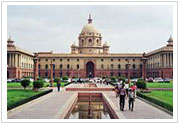
The INC was out of power between 1977 and 1980, when the Janata Party won the election owing to public discontent with the "Emergency" declared by the then Prime Minister Indira Gandhi.
In 1989, a Janata Dal-led National Front coalition in alliance with the Left Front coalition won the elections but managed to stay in power for only two years.
The years 1996–1998 were a period of turmoil in the federal government with several short-lived alliances holding sway. The BJP formed a government briefly in 1996, followed by the United Front coalition. In 1998, the BJP formed the National Democratic Alliance (NDA) with several regional parties and became the first non-Congress government to complete a full five-year term. In the 2004 Indian elections, the INC won the largest number of Lok Sabha seats and formed a government with a coalition called the United Progressive Alliance (UPA), supported by various left-leaning parties and members opposed to the BJP.
Since its independence in 1947, India has maintained cordial relationships with most nations. It took a leading role in the 1950s by advocating the independence of European colonies in Africa and Asia. India is a founding member of the Non-Aligned Movement. After the Sino-Indian War and the Indo-Pakistani War of 1965, India's relationship with the Soviet Union warmed at the expense of ties with the United States and continued to remain so until the end of the Cold War. India has fought four wars with Pakistan, primarily over Kashmir. India also fought and won an additional war with Pakistan for the liberation of Bangladesh in 1971.
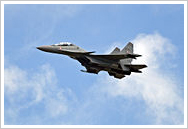
In recent years, India has played an influential role in the ASEAN, SAARC, and the WTO. India is a founding member and long time supporter of the United Nations, with over 55,000 Indian military and police personnel having served in thirty-five UN peace keeping operations deployed across four continents. Despite criticism and military sanctions, India has consistently refused to sign the CTBT and the NPT, preferring instead to maintain sovereignty over its nuclear program. Recent overtures by the Indian government have strengthened relations with the United States, China, and Pakistan. In the economic sphere, India has close relationships with other developing nations in South America, Asia, and Africa.
India maintains the third largest military force in the world by number of active troops, which consists of the Indian Army, Navy, and Air Force. Auxiliary forces such as the Paramilitary Forces, the Coast Guard, and the Strategic Forces Command also come under the military's purview. The President of India is the supreme commander of the Indian armed forces. India became a nuclear power in 1974 after conducting an initial nuclear test, Operation Smiling Buddha. Further underground testing in 1998 led to international military sanctions against India, which were gradually withdrawn after September 2001. India maintains a "no first use" nuclear policy and has a "strong nuclear non-proliferation record" according to the White House, despite not being a signatory to the Nuclear Non-Proliferation Treaty.
India is a federal republic of twenty-eight states and seven Union Territories. All states, the union territory of Puducherry, and the National Capital Territory of Delhi have elected governments. The other five union territories have centrally appointed administrators and hence are under direct rule of the President. In 1956, under the States Reorganisation Act, states were formed on a linguistic basis. Since then, this structure has remained largely unchanged. Each state or union territory is divided into basic units of government and administration called districts. There are nearly 600 districts in India. The districts in turn are further divided into tehsils and eventually into villages.
Table Added
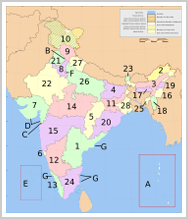
India, the major portion of the Indian subcontinent, sits atop the Indian tectonic plate, a minor plate within the Indo-Australian Plate.
India's defining geological processes commenced seventy-five million years ago, when the Indian subcontinent, then part of the southern supercontinent Gondwana, began a northeastwards drift-lasting fifty million years-across the then unformed Indian Ocean. The subcontinent's subsequent collision with the Eurasian Plate and subduction under it, gave rise to the Himalayas, the planet's highest mountains, which now abut India in the north and the north-east.
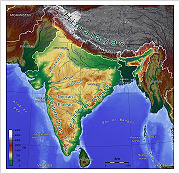
In the former seabed immediately south of the emerging Himalayas, plate movement created a vast through, which, having gradually been filled with river-borne sediment, now forms the Indo-Gangetic Plain. To the west of this plain, and cut off from it by the Aravalli Range, lies the Thar Desert. The original Indian plate now survives as peninsular India, the oldest and geologically most stable part of India, and extending as far north as the Satpura and Vindhya ranges in central India. These parallel ranges run from the Arabian Sea coast in Gujarat in the west to the coal-rich Chota Nagpur Plateau in Jharkhand in the east. To their south, the remaining peninsular landmass, the Deccan Plateau, is flanked on the left and right by the coastal ranges, Western Ghats and Eastern Ghats respectively; the plateau contains the oldest rock formations in India, some over one billion years old. Constituted in such fashion, India lies to the north of the equator between 6°44' and 35°30' north latitude and 68°7' and 97°25' east longitude.
India's coast is 7,517 kilometers (4,671 mi) long; of this distance, 5,423 kilometers (3,370 mi) belong to peninsular India, and 2,094 kilometers (1,301 mi) to the Andaman, Nicobar, and Lakshadweep Islands. According to the Indian naval hydrographic charts, the mainland coast consists of the following: 43% sandy beaches, 11% rocky coast including cliffs, and 46% mudflats or marshy coast.
Major Himalayan-origin rivers that substantially flow through India include the Ganges and the Brahmaputra, both of which drain into the Bay of Bengal. Important tributaries of the Ganges include the Yamuna and the Kosi, whose extremely low gradient causes disastrous floods every year. Major peninsular rivers whose steeper gradients prevent their waters from flooding include the Godavari, the Mahanadi, the Kaveri, and the Krishna, which also drain into the Bay of Bengal; and the Narmada and the Tapi, which drain into the Arabian Sea. Among notable coastal features of India are the marshy Rann of Kutch in western India, and the alluvial Sundarbans delta, which India shares with Bangladesh. India has two archipelagos: the Lakshadweep, coral atolls off India's south-western coast; and the Andaman and Nicobar Islands, a volcanic chain in the Andaman Sea.
India's climate is strongly influenced by the Himalayas and the Thar Desert, both of which drive the monsoons. The Himalayas prevent cold Central Asian katabatic winds from blowing in, keeping the bulk of the Indian subcontinent warmer than most locations at similar latitudes. The Thar Desert plays a crucial role in attracting the moisture-laden southwest summer monsoon winds that, between June and October, provide the majority of India's rainfall. Four major climatic groupings predominate in India: tropical wet, tropical dry, subtropical humid, and montane.
India, which lies within the Indomalaya ecozone, displays significant biodiversity. Being one of seventeen megadiverse countries, it is home to 7.6% of all mammalian, 12.6% of all avian, 6.2% of all reptilian, 4.4% of all amphibian, 11.7% of all fish, and 6.0% of all flowering plant species. Many ecoregions, such as the shola forests, exhibit extremely high rates of endemism; overall, 33% of Indian plant species are endemic. India's forest cover ranges from the tropical rainforest of the Andaman Islands, Western Ghats, and North-East India to the coniferous forest of the Himalaya. Between these extremes lie the sal-dominated moist deciduous forest of eastern India; the teak-dominated dry deciduous forest of central and southern India; and the babul-dominated thorn forest of the central Deccan and western Gangetic plain.
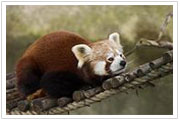
Important Indian trees include the medicinal neem, widely used in rural Indian herbal remedies. The pipal fig tree, shown on the seals of Mohenjo-daro, shaded Gautama Buddha as he sought enlightenment.
Many Indian species are descendants of taxa originating in Gondwana, to which India originally belonged. Peninsular India's subsequent movement towards, and collision with, the Laurasian landmass set off a mass exchange of species. However, volcanism and climatic changes 20 million years ago caused the extinction of many endemic Indian forms. Soon thereafter, mammals entered India from Asia through two zoogeographical passes on either side of the emerging Himalaya. Consequently, among Indian species, only 12.6% of mammals and 4.5% of birds are endemic, contrasting with 45.8% of reptiles and 55.8% of amphibians. Notable endemics are the Nilgiri leaf monkey and the brown and carmine Beddome's toad of the Western Ghats. India contains 172, or 2.9%, of IUCN-designated threatened species. These include the Asiatic Lion, the Bengal Tiger, and the Indian white-rumped vulture, which suffered a near-extinction from ingesting the carrion of diclofenac-treated cattle.
In recent decades, human encroachment has posed a threat to India's wildlife; in response, the system of national parks and protected areas, first established in 1935, was substantially expanded. In 1972, India enacted the Wildlife Protection Act and Project Tiger to safeguard crucial habitat; in addition, the Forest Conservation Act was enacted in 1980. Along with more than five hundred wildlife sanctuaries, India hosts thirteen biosphere reserves, four of which are part of the World Network of Biosphere Reserves; twenty-five wetlands are registered under the Ramsar Convention.
For most of its post-independence history, India adhered to a quasi-socialist approach with strict government control over private sector participation, foreign trade, and foreign direct investment. However, since 1991, India has gradually opened up its markets through economic reforms and reduced government controls on foreign trade and investment. Foreign exchange reserves have risen from US$5.8 billion in March 1991 to US$300 billion in March, 2008, while federal and state budget deficits have decreased. Privatization of publicly-owned companies and the opening of certain sectors to private and foreign participation has continued amid political debate. With a GDP growth rate of 9.4% in 2006-07, the economy is among the fastest growing in the world. India's GDP in terms of USD exchange-rate is US$1.089 Trillion . When measured in terms of purchasing power parity (PPP), India has the world's third largest GDP at US$4.726 trillion. India's per capita income (nominal) is US$ 1004 , while its per capita (PPP) is US$ 4182.
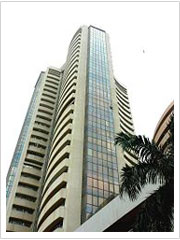
India has the world's second largest labour force, with 516.3 million people, 60% of whom are employed in agriculture and related industries; 28% in services and related industries; and 12% in industry.
Major agricultural crops include rice, wheat, oilseed, cotton, jute, tea, sugarcane, and potatoes. The agricultural sector accounts for 28% of GDP; the service and industrial sectors make up 54% and 18% respectively. Major industries include automobiles, cement, chemicals, consumer electronics, food processing, machinery, mining, petroleum, pharmaceuticals, steel, transportation equipment, and textiles.
Although the Indian economy has grown steadily over the last two decades; its growth has been uneven when comparing different social groups, economic groups, geographic regions, and rural and urban areas. Income inequality in India is relatively small (Gini coefficient: 32.5 in year 1999–2000), though it has been increasing of late. Wealth distribution in India is fairly uneven, with the top 10% of income groups earning 33% of the income. Despite significant economic progress, a quarter of the nation's population earns less than the government-specified poverty threshold of $0.40 per day. In 2004–2005, 27.5% of the population was living below the poverty line.
More recently, India has capitalised on its large pool of educated, English-speaking people, and trained professionals to become an important outsourcing destination for multinational corporations and a popular destination for medical tourism. India has also become a major exporter of software as well as financial, research, and technological services. Its natural resources include arable land, bauxite, chromite, coal, diamonds, iron ore, limestone, manganese, mica, natural gas, petroleum, and titanium ore.
In 2007, estimated exports stood at US$140 billion and imports were around US$224.9 billion. Textiles, jewellery, engineering goods and software are major export commodities. While crude oil, machineries, fertilizers, and chemicals are major imports. India's most important trading partners are the United States, the European Union, and China.
Population density map of India. With an estimated population of 1.12 billion, India is the world's second most populous country. Almost 70% of Indians reside in rural areas, although in recent decades migration to larger cities has led to a dramatic increase in the country's urban population. India's largest cities are Mumbai (formerly Bombay), Delhi, Kolkata (formerly Calcutta), Chennai (formerly Madras), Bengaluru (formerly Bangalore), Hyderabad and Ahmadabad.
India is the second most culturally, linguistically and genetically diverse geographical entity after the African continent. India is home to two major linguistic families: Indo-Aryan (spoken by about 74% of the population) and Dravidian (spoken by about 24%). Other languages spoken in India come from the Austro-Asiatic and Tibeto-Burman linguistic families. Hindi, with the largest number of speakers, is the official language of India. English, which is extensively used in business and administration, has the status of a 'subsidiary official language.The constitution also recognises in particular 21 other languages that are either abundantly spoken or have classical status.
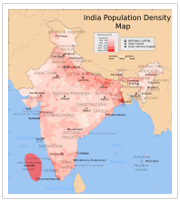
The number of dialects in India is as high as 1,652.Over 800 million Indians (80.5%) are Hindu. Other religious groups include Muslims (13.4%), Christians (2.3%), Sikhs (1.9%), Buddhists (0.8%), Jains (0.4%), Jews, Zoroastrians, Bahá'ís and others. Tribals constitute 8.1% of the population.
India's literacy rate is 64.8% (53.7% for females and 75.3% for males). The state of Kerala has the highest literacy rate (91%); Bihar has the lowest (47%). The national human sex ratio is 944 females per 1,000 males. India's median age is 24.9, and the population growth rate of 1.38% per annum; there are 22.01 births per 1,000 people per year.
India's culture is marked by a high degree of syncretism and cultural pluralism. It has managed to preserve established traditions while absorbing new customs, traditions, and ideas from invaders and immigrants.
Multicultural concerns have long informed India's history and traditions, constitution and political arrangements.
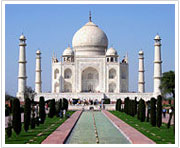
Indian architecture is one area that represents the diversity of Indian culture.Much of it, including notable monuments such as the Taj Mahal and other examples of Mughal architecture and South Indian architecture, comprises a blend of ancient and varied local traditions from several parts of the country and abroad. Vernacular architecture also displays notable regional variation.
Indian music covers a wide range of traditions and regional styles. Classical music is split mainly between the North Indian Hindustani and South Indian Carnatic traditions.
Highly regionalised forms of popular music include filmi and folk music; the syncretic tradition of the bauls is a well-known form of the latter.
Indian dance too has diverse folk and classical forms. Among the well-known folk dances are the bhangra of the Punjab, the bihu of Assam, the chhau of Bihar and Orissa and the ghoomar of Rajasthan. Eight dance forms, many with narrative forms and mythological elements, have been accorded classical dance status by India's National Academy of Music, Dance, and Drama. These are: bharatanatyam of the state of Tamil Nadu, kathak of Uttar Pradesh, kathakali and mohiniyattam of Kerala, kuchipudi of Andhra Pradesh, manipuri of Manipur, odissi of the state of Orissa and the sattriya of Assam.
Theatre in India often incorporates music, dance, and improvised or written dialogue. Often based on Hindu mythology, but also borrowing from medieval romances, and news of social and political events, Indian theatre includes the bhavai of state of Gujarat, the jatra of West Bengal, the nautanki and ramlila of North India, the tamasha of Maharashtra, the terukkuttu of Tamil Nadu, and the yakshagana of Karnataka
The Mahabodhi Temple, a UNESCO World Heritage Site, at Bodhgaya in Bihar, is one of the four holy sites related to the life of the Lord Buddha, and particularly to the attainment of Enlightenment. The first temple was built by Emperor Asoka in the 3rd century BC, and the present temple dates from the 5th century BC or 6th centuries. It is one of the earliest Buddhist temples built entirely in brick, still standing in India, from the late Gupta period. The Indian film industry is the largest in the world. Bollywood, based in Mumbai, makes commercial Hindi films and is the most prolific film industry in the world. Established traditions also exist in Bengali, Kannada, Malayalam, Marathi, Tamil, and Telugu language cinemas.
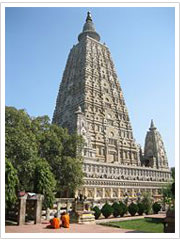
The earliest works of Indian literature were transmitted orally and only later written down. These included works of Sanskrit literature – such as the early Vedas, the epics Mahabharata and Ramayana, the drama Abhijnanasakuntalam (The Recognition of sakuntala), and poetry such as the Mahakavya – and the Tamil language Sangam literature. Among Indian writers of the modern era active in Indian languages or English, Rabindranath Tagore won the Nobel Prize in 1913.
Indian cuisine is characterized by a wide variety of regional styles and sophisticated use of herbs and spices. The staple foods in the region are rice (especially in the south and the east) and wheat (predominantly in the north). Spices originally native to the Indian subcontinent that are now consumed world wide include black pepper; in contrast, hot chili peppers, popular across India, were introduced by the Portuguese. Traditional Indian dress varies across the regions in its colours and styles and depends on various factors, including climate. Popular styles of dress include draped garments such as sari for women and dhoti or lungi for men; in addition, stitched clothes such as salwar kameez for women and kurta-pyjama and European-style trousers and shirts for men, are also popular.
Many Indian festivals are religious in origin, although several are celebrated irrespective of caste and creed. Some popular festivals are Diwali, Thai Pongal, Holi, Onam, Vijayadashami, Durga Puja, Eid ul-Fitr, Bakr-Id, Christmas, Buddha Jayanti and Vaisakhi. India has three national holidays. Other sets of holidays, varying between nine and twelve, are officially observed in individual states. Religious practices are an integral part of everyday life and are a very public affair. Traditional Indian family values are highly respected, although urban families now prefer nuclear family system due to the socio-economic constraints imposed by traditional joint family system.
India, which lies within the Indomalaya ecozone, displays significant biodiversity. Being one of seventeen megadiverse countries, it is home to 7.6% of all mammalian, 12.6% of all avian, 6.2% of all reptilian, 4.4% of all amphibian, 11.7% of all fish, and 6.0% of all flowering plant species. Many ecoregions, such as the shola forests, exhibit extremely high rates of endemism; overall, 33% of Indian plant species are endemic. India's forest cover ranges from the tropical rainforest of the Andaman Islands, Western Ghats, and North-East India to the coniferous forest of the Himalaya. Between these extremes lie the sal-dominated moist deciduous forest of eastern India; the teak-dominated dry deciduous forest of central and southern India; and the babul-dominated thorn forest of the central Deccan and western Gangetic plain.
India's national sport is field hockey although cricket is the most popular sport in India. In some states, particularly those in the northeast and the states of West Bengal, Goa, and Kerala, football (soccer) is also a popular sport. In recent times, tennis has also gained popularity. Chess, commonly held to have originated in India, is also gaining popularity with the rise in the number of Indian grandmasters. Traditional sports include kabaddi, kho kho, and gilli-danda, which are played nationwide. India is home to the age-old disciplines of yoga and ayurveda and to the ancient martial arts, Kalarippayattu and Varma Kalai.